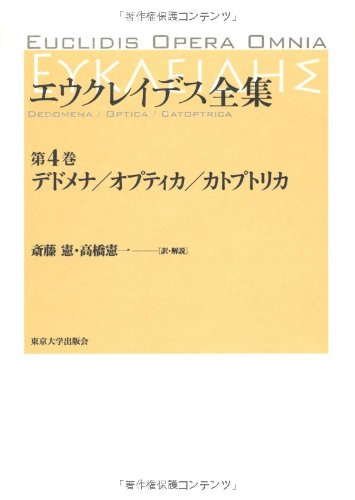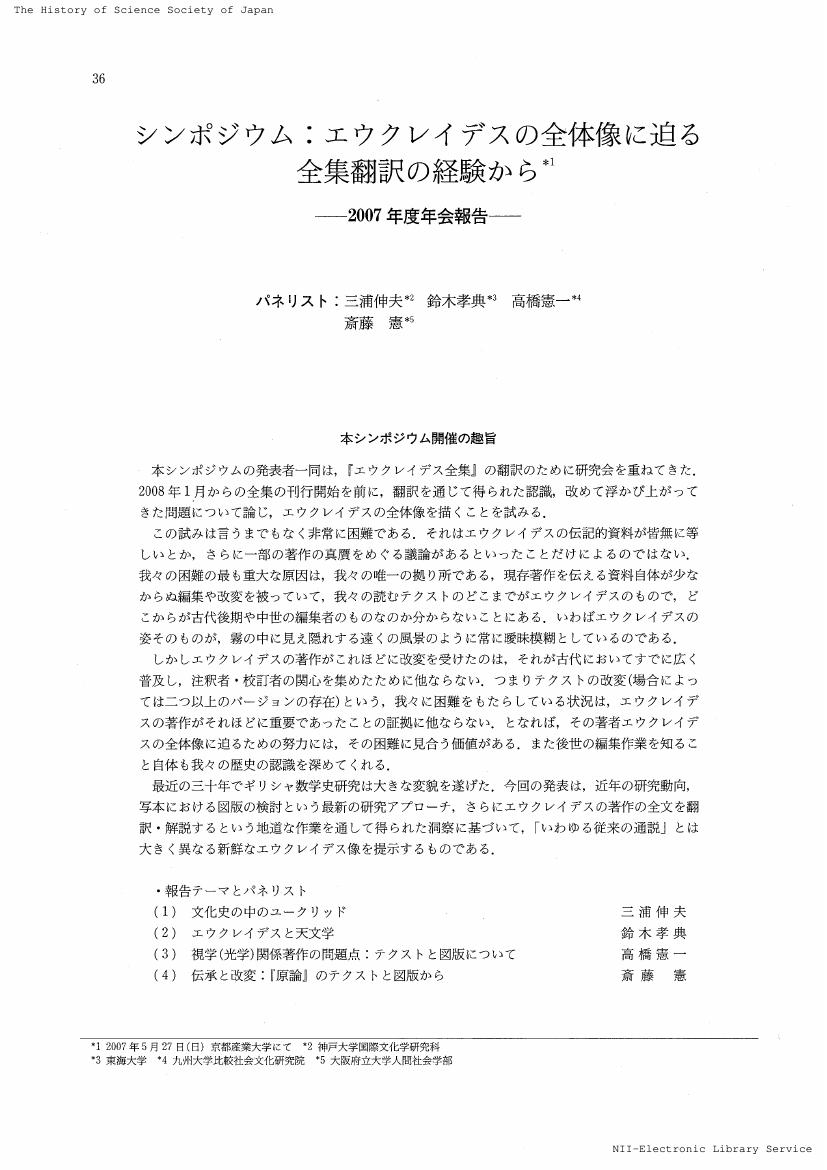5 0 0 0 OA 腸疾患における腸内細菌のかかわり
- 著者
- 安藤 朗 藤本 剛英 高橋 憲一郎
- 出版者
- 一般社団法人 日本内科学会
- 雑誌
- 日本内科学会雑誌 (ISSN:00215384)
- 巻号頁・発行日
- vol.102, no.11, pp.2983-2989, 2013-11-10 (Released:2014-11-10)
- 参考文献数
- 19
- 被引用文献数
- 1
我々は腸内細菌を利用してさまざまな食物からエネルギーを獲得している.腸内細菌は糖吸収を促がすだけでなく,食物繊維を発酵して脂肪酸を誘導しこれらがエネルギーとして利用される.一方,腸内細菌の存在は複雑な免疫機構の発達を誘導した.腸管は生体内最大のリンパ装置とされ,ここでは腸内細菌や食物抗原に対する免疫誘導と寛容が巧妙にコントロールされ過剰な免疫応答による組織障害が未然に防がれている.このホメオスタシスの乱れが炎症性腸疾患の発症につながる.一方,機能性消化管障害は,腹痛と便通異常などの症状があるにもかかわらず消化管検査では症状の原因を特定できないことから,腸管運動の機能障害と内臓神経の知覚過敏に起因する疾患と考えられてきた.しかし,最近の研究から機能性消化管障害の病態にも腸内細菌叢の関与が示唆されている.ここでは,腸疾患と腸内細菌叢のかかわり,腸内細菌を標的とした治療の実際について解説した.
2 0 0 0 デドメナ/オプティカ/カトプトリカ
- 著者
- [エウクレイデス著] 斎藤憲 高橋憲一訳・解説
- 出版者
- 東京大学出版会
- 巻号頁・発行日
- 2010
- 著者
- 羽片 俊夫 東 慎一郎 伊藤 和行 高橋 憲一
- 出版者
- 日本科学史学会
- 雑誌
- 科学史研究. 第II期 (ISSN:00227692)
- 巻号頁・発行日
- vol.42, no.228, pp.231-242, 2003-12-25
1 0 0 0 OA シンポジウム:エウクレイデスの全体像に迫る 全集翻訳の経験から-2007年度年会報告-
1 0 0 0 OA シンポジウム:ガリレオ科学 : 新しい自然学とその歴史的背景(2003年度年会報告)
1 0 0 0 OA シンポジウム:科学史研究と哲学 : 2002年度年会報告
1 0 0 0 OA シンポジウム:「ユークリッドの種々相」 1993年日本科学史学会年会報告
1 0 0 0 OA ユークリッドの『反射光学』:真作性問題の再検討に向けて -ハイベルク説批判-
- 著者
- 高橋 憲一
- 出版者
- 日本科学史学会
- 雑誌
- 科学史研究 (ISSN:21887535)
- 巻号頁・発行日
- vol.29, no.173, pp.1-12, 1990 (Released:2021-09-01)
Contrary to the title of our paper, the Catoptrica is generally regarded as a pseudo-Euclidean work―a late recension of a genuine Euclidean one, probably written by Theon of Alexandria. Almost all historians of science have accepted this interpretation, which was proposed by J. L. Heiberg and later elaborated by A. Lejeune. In this paper the author intends first to examine the validity of this widespread interpretation, focussing mainly on Heiberg's arguments, and secondly to propose an alternative interpretation. Heiberg's arguments can be divided into three groups, which concern respectively : (Gl) theoretical contents of the Catoprica (G2) scanty testimonies in antiquity (G3) stylistic analyses of the Greek text (Gl)is, it seems, the most important reason to have led him to the inauthenticity of the work. His arguments in this regard consist of pointing out, on the one hand, inaccurate proof procedures and lack of mathematical rigor(for Propsitions 7-12, 16-18), and, on the other, fallacious assertions(for Postulates 4 & 5). The present author refutes the former by showing Heiberg's misunderstanding of the propositions, and the latter by proposing a new interpretation of the postulates, a kernel of which is the assumption, indicated by the use of 〇 vKerc and supported by the use of the same word in Euclid's Optica, Prop. 3, that observer' s eye moves around the object of sight, looking at the image in the mirror. With the collapse of reasons in (Gl), Heiberg's argument in (G2) is deemed to lose its force. We havz no right to doubt the truth of both Proclus' ascription of the work to Euclid and Euclid's own allusion to the work in his Optica, Prop.19. Concerning (G3), it is shown that his argument is far from convincing. It never supports a hypothesis that Theon was a pseudo-Euclid who compiled the work, but rather indicates, against his intention, that the work has same characteristic style as the genuine Euclidean Optica, probably inherited from optical research before Euclid. Thus if the Optica has the right to claim Euclidean authenticity, the Catoptrica also has, we must admit, the same right in its extant form as handed down to us.
- 著者
- 高橋 憲一
- 出版者
- The Japanese Society for the Philosophy of Education
- 雑誌
- 教育哲学研究 (ISSN:03873153)
- 巻号頁・発行日
- vol.1978, no.37, pp.81-86, 1978-05-10 (Released:2009-09-04)
- 参考文献数
- 6
1 0 0 0 OA ヒューマニズムの再確認
- 著者
- 高橋 憲一
- 出版者
- 教育哲学会
- 雑誌
- 教育哲学研究 (ISSN:03873153)
- 巻号頁・発行日
- vol.1973, no.27, pp.1-6, 1973-04-30 (Released:2009-09-04)
1 0 0 0 OA パウル・ヘーバーリンとその学会
- 著者
- 高橋 憲一
- 出版者
- 教育哲学会
- 雑誌
- 教育哲学研究 (ISSN:03873153)
- 巻号頁・発行日
- vol.1972, no.25, pp.68-71, 1972-05-20 (Released:2009-09-04)
1 0 0 0 IR 科学革命初期の宇宙論と創造
- 著者
- 高橋 憲一
- 出版者
- 九州大学大学院比較社会文化学府
- 雑誌
- 比較社会文化 (ISSN:13411659)
- 巻号頁・発行日
- vol.14, pp.23-32, 2008
Today scientists, in their research, are not or less concerned with religious belief. But today's common senseis not simply true for those who were engaged in scientific research at the early phase of the Scientific Revolution. Especially as for the motives of their study of the universe, we can detect religious motives and their reflections in their theoretical contents. In this essay the author takes up representative cases -- Copernicus, Bruno, Kepler and Galileo -- and tries to investigate relationships between their theoretical setups and the creation doctrine of the Bible. For all of them it was, so to speak, the major premise that the universe was a work of God the creator. Consequently the scientific personality of each scientist may be clarified by looking at where to find God's hands of creation in this universe, or in other wordsm, at what aspect of God's attributions was to be emphasized: for instance, His beauty, infinity, trinity, or His mathematical intellect.
1 0 0 0 OA リハビリテーションにおける痛みの評価 : McGill痛み質問表の試み
- 著者
- 高橋 憲一 福田 修 飯坂 英雄 鈴木 重男 平岡 幸雄 三浦 和雄 橋本 京子 楢山 浩生 小関 英幹 青山 磨菜
- 出版者
- 北海道大学医療技術短期大学部
- 雑誌
- 北海道大学医療技術短期大学部紀要 (ISSN:09152083)
- 巻号頁・発行日
- vol.6, pp.101-113, 1993-12
- 著者
- 高橋 憲一
- 出版者
- 日本科学史学会
- 雑誌
- 科学史研究. 第II期 (ISSN:00227692)
- 巻号頁・発行日
- vol.47, no.246, pp.121-124, 2008-06-25







